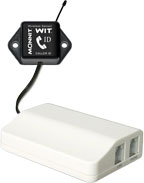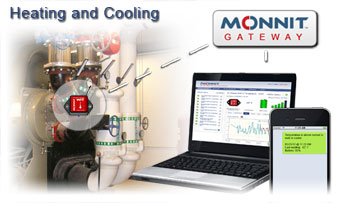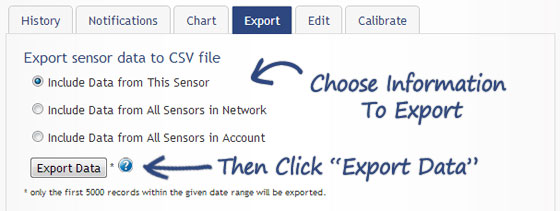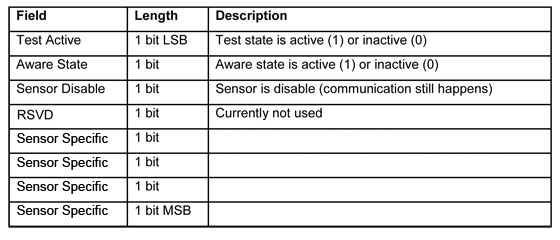|
Having trouble viewing this email? View it in your browser.
|

|
|
|

|


|
New Caller ID Sensor
Monnit has the opportunity to work with many industry leading OEM's and Resellers. The outcome of these relationships often yields some very unique and useful products. Monnit will soon be releasing a new wireless sensor as the result of recent collaboration efforts. The Wireless Caller ID sensor detects incoming phone calls on any land line phone and sends the caller ID information to you via SMS text or email.
 • Available in 900, 868
• Available in 900, 868
and 433MHz Frequencies.
• Monitors incoming caller ID
information (if available) including
phone number and Caller ID.
• Records; date of the call,
time of the call, duration of the call,
telephone line connected, phone off
hook, phone on hook and phone off hook
for extended time without dialing.
• System supports U.S. phone numbers
and international dialing up to
15 numbers.
The new Caller ID Sensor will be available soon as an OEM only offering.
For more information on this new product or be notified when it is available for purchase, please email us at sales@monnit.com
|
|


|

|

Let's take a look in our crystal ball to see what the future holds at Monnit?
The Monnit development team is aggressively working on new products to expand and enhance our current product offering based on customer needs. We have received requests for a Simple Network Management Protocol (SNMP) Gateway. If you would like to learn more about the development efforts of our team on this new product or be notified when it becomes available, please email us at sales@monnit.com.
back to top
|
|

|

Using Wireless Sensors For Monitoring Heating and Cooling Systems
Are you monitoring your Heating and Cooling systems for efficient operation and predictive maintenance? Do you know how often your HVAC system is running and if it is running within its correct specifications? Deviations from specified parameters if left unchecked, can cause expensive repairs and downtime.
Using Monnit Wireless Sensors to remotely monitor your HVAC systems, allows you to maintain efficient operation and schedule maintenance or other actions to avoid the consequences of failure, before the failure occurs. Monnit wireless sensor systems can help you monitor equipment to help you detect issues before they become serious and costly. We recommend using Monnit's wireless temperature sensors to monitor temperatures around your building and Monnit's affordable wireless activity timer sensors to track and monitor the operation of your HVAC equipment.
Detect HVAC issues before costly failures occur with Monnit Wireless Sensors!
Learn More About Wireless Sensor Solutions for Heating and Cooling System Monitoring »
back to top
|
|

|

by The WiSe Guys
|

Exporting sensor data from your iMonnit account.
The following steps will guide you through the process of exporting your sensor data to a CSV file and help you understand the format of the data file.
Exporting Sensor Data.
• Click on the sensor name in the "Sensor List" window.
• Click the "Export" tab from the sensor data window.
• Choose the information that you want to export.
(You can export data for the viewed sensor, or choose
to include data from all sensors in the sensor's network
or the entire account.)
• Click the "Export Data" button.
• The .csv file will be downloaded to your browsers default download directory. You can open this
file in any spreadsheet editing program such as Microsoft® Excel.

Data File - Column (Field) Definitions
1. MessageID: Unique identifier of the message in our database.
2. Sensor ID: If multiple sensors are exported you can distinguish which reading was from
which using this number even if the names for some reason are the same.
3. Date: The date the message was transmitted from the sensor.
4. Sensor: Name you have given the sensor to Identify it.
5. Signal Strength: Strength of communication signal between the sensor and the gateway,
shown as percentage value.
6. Received Signal: the signal strength measured in RSSI (From Wikipedia: In telecommunications,
Received Signal Strength Indicator (RSSI) is a measurement of the power present in a received
radio signal.) This is the number that is used to calculate the "Signal Strength" column which we
show as a percentage. For certain engineers this column is more useful than the calculated
percentage so we display both to fulfill all the needs of our users.
7. Sensor State: Binary field represented as an integer containing information about the state of
the sensor when the message was transmitted. (See "Sensor State" information below).
8. Battery: Estimated life remaining of the battery.
9. Text: Data transformed and presented as it is shown in the monitoring portal.
10. Data: Raw data as it is stored from the sensor.
11. Alert: Boolean indicating if this reading triggered a notification to be sent from the system.
12. Voltage: actual voltage measured at the sensor battery used to calculate battery percentage,
similar to Received Signal you can use one or the other or both if they help you.
13. Plot Value: Data presented with any transforms applied but without additional text labels.
14. GatewayID: The Identifier of the gateway that relayed the data from the sensor.
Sensor State (Explained)
The integer presented here is generated from a single byte of stored data. A byte consists of 8 bits of data that we read as Boolean (True (1)/False (0)) fields.

Using a temperature sensor as an example.
If the sensor is using factory calibrations the Calibrate Active field is set True (1) so the bit values are
00010000 and it is represented as 16.
If the sensor is outside the Min or Max threshold, the Aware State is set True (1) so the bit values are
00000010 and it is represented as 2.
If the customer has calibrated the sensor this field the Calibrate Active field is set False (0) AND the sensor is operating inside the Min and Max Thresholds, the bits look like 00000000 this is represented as 0.
If the sensor is using factory calibrations and it is outside the threshold the bit values are 00010010 and it is represented as 18
(16 + 2 because both the bit in the 16 value is set and the bit in the 2 value is set).
Note: These two are the only bits that typically observed outside of our testing procedures.
For more information on using Monnit wireless sensors, visit the support section of our website.
back to top
|
|
 |
|
All trademarks are property of their respective owners. © 2012 Monnit Corp. All Rights Reserved.
Monnit Corporation / ph 801-561-5555 / www.monnit.com

|
|
|



